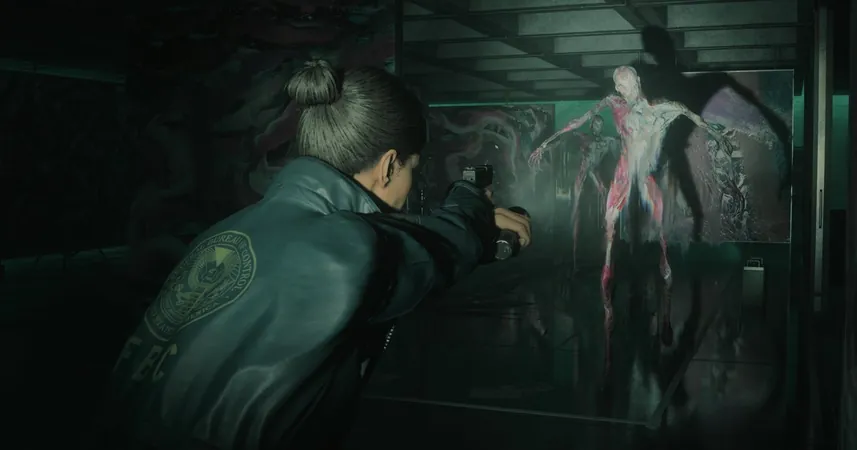
Alan Wake 2’s The Lake House: A Gripping Exploration of the Art World’s Dark Side
2024-11-07
Author: Arjun
As players step into the eerie halls of The Lake House in *Alan Wake 2*, they are greeted by the haunting sound of hundreds of typewriters clacking in unison. This cacophony of mechanical noise sets the stage for a sharp critique of the modern artistic landscape. Kiran Estevez, the game’s protagonist, enters armed with a pistol and flashlight, ready to uncover the truth behind the automated writing process that seeks to replicate the creative genius of Alan Wake himself.
The walls of The Lake House are adorned with whiteboards and documents that reveal a chilling ambition: to generate stories that mimic Wake's writing style, tone, and content so accurately that it becomes indistinguishable from the original. This is the brainchild of Jules Marmont, the obsessive head of the FBC center, and his wife, Diana, who are experimenting with synthetic art creation. They believe that if they can imitate Wake's raw creative passion, they can elicit a response from the mysterious entity lurking within Cauldron Lake.
This premise is far from subtle; it serves as a bold declaration against a culture that increasingly devalues the very nature of art and its creators. In an age where generative AI has begun to dominate creative spaces, *The Lake House* offers a stark reminder that the exploitation of artists has been systemic, and now it's morphing into a dangerous trend where art is seen merely as a commodity.
However, the game doesn't shy away from critiquing itself. While it raises important questions about the nature of artistic integrity, it also examines Alan Wake’s flaws—his solipsism and occasional selfishness. The obsession with typewriters and the tracking of Wake's preferences denounce the superficial fetishization of artistic symbols over the genuine love for the creative process.
In one poignant moment, the text whispers about the idea that recreating good art could be as simple as duplicating a successful artist's conditions—an idea evocative of Charles Bukowski’s musings on the essence of artistry. Wake's portrayal as a tortured literary icon—complete with his elbow patches and brooding demeanor—invites players to reflect on the often romanticized notions of the artist as a misunderstood genius.
Though the narrative of *Alan Wake 2* is labyrinthine, layered with references and rich themes of creativity, the game asserts that not all acts of creation are inherently noble, even if they are purposeful. This duality raises troubling questions about the commodification of artistic intent; how easily can genuine expression be reduced to mere imitation?
One of the game’s most thought-provoking documents explores the notion of “Emotion” depicted as a quantifiable entity, reflecting today’s obsession with analytics in the art world. This begs the question: can true art—driven by emotion and intention—ever be compressed to numbers?
Reflecting on recent discussions surrounding the capabilities of generative AI, critics like Ted Chiang implore us to consider that while technology can produce language, it cannot replicate the emotional core that defines real human expression. In *The Lake House*, players will encounter documents that showcase chilling experiments attempting to measure the emotional potency of art, reminding us that if art is purely about utility, then it is at risk of losing its soul.
Interestingly, as the head of Netflix's generative AI division claims to usher in a new era of creativity, one can't overlook the irony: a system that threatens the livelihoods of creators is branded as a beacon of freedom. The juxtaposition is stark; while rhetoric emphasizes empowerment, the reality often means the erosion of job security in creative industries.
When I engage with *The Lake House*—a fantastically intricate horror experience—I'm drawn into a world teeming with purpose and vitality. *Alan Wake 2* brims with themes that transcend merely selling a game; it’s a rich tapestry that celebrates the infinite ways art can convey emotion and narrative.
Throughout the game, various mediums—film, music, dance, and more—intertwine to enrich the storytelling experience, emphasizing that every form of expression communicates ideas uniquely. For an industry grappling with the implications of generative AI, *The Lake House* channels frustration and despair into a masterclass of artistic expression, reminding us why the human element in creativity is irreplaceable.
In a world increasingly enamored with automation, *Alan Wake 2: The Lake House* stands as a powerful counter-narrative, brilliantly challenging our perceptions of art, creation, and the true meaning of expression in our lives.

 Brasil (PT)
Brasil (PT)
 Canada (EN)
Canada (EN)
 Chile (ES)
Chile (ES)
 España (ES)
España (ES)
 France (FR)
France (FR)
 Hong Kong (EN)
Hong Kong (EN)
 Italia (IT)
Italia (IT)
 日本 (JA)
日本 (JA)
 Magyarország (HU)
Magyarország (HU)
 Norge (NO)
Norge (NO)
 Polska (PL)
Polska (PL)
 Schweiz (DE)
Schweiz (DE)
 Singapore (EN)
Singapore (EN)
 Sverige (SV)
Sverige (SV)
 Suomi (FI)
Suomi (FI)
 Türkiye (TR)
Türkiye (TR)